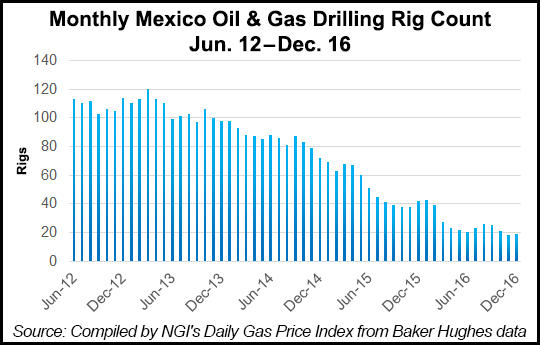Regulatory | Mexico | NGI All News Access | NGI The Weekly Gas Market Report
In Mexico, Energy Reform Is Local, Too
Mexico’s energy reforms are a nationwide affair, but much of the action — and potential conflict — will happen at the state and municipal level, where the drill bits and pipelines meet the ground, speakers said Wednesday at a conference in Monterrey, the capital of northeastern state Nuevo León.

According to presenters at the Mexico Infrastructure Projects Forum, Mexico’s northeast region holds close to 85% of the country’s shale gas reserves and is its third-largest wind energy resource base. The region also has the highest energy demand in Mexico except for the Mexico City metro area, and manufacturers there produce goods for domestic and export markets.
While energy infrastructure in northeastern Mexico is the country’s most developed, it is still lacking — and that is keeping the region from developing its full economic potential, conference speakers said.
State officials are keen to have local private-sector firms participate in the opening energy markets, and they also want to attract foreign investment to the region. However, Gregorio Canales, Nuevo León state secretary of economic development, said, “Mexico’s energy reform was designed and enacted with state governments out of sight and mind.”
On the one hand, the legislative reforms were made to federal laws, creating new federal institutions and refurbishing old ones. On the other hand, specific projects take place at the municipal level of government and often involve many entities. Thus, state governments have had to figure out how to fill in the gaps in the reform’s legal and institutional architecture.
Opportunities at the local level come with challenges, said Rogelio Montemayor, president of private-sector consortium Coahuila Energy Cluster. For instance, officials with municipal governments, particularly those in rural areas, must be able to deal with sophisticated investors while handling demand from their largely impoverished residents.
Energy reform runs the risk of sidelining state governments, Montemayor warned, “and this could lead to local development policy failures similar to those made under NAFTA, a generation ago.”
Private companies interested in investing in the energy sector in these areas are likely to run into operational obstacles before too long. Therefore, state governments must either help municipal governments develop these capabilities or, more likely in the short term, step in to manage relationships successfully.
The Coahuila and Nuevo León state governments have tapped their private sectors to create consortia aimed at leveraging opportunities and planning investments.
Montemayor said this involves everything from developing physical infrastructure to retooling local education systems to train workers with the skills needed to participate in the emerging energy market opportunities.
Canales agreed that state governments are instrumental in mobilizing resources, but he warned that jumping into the fray without having first made local legislation compatible with the federal reforms — for instance, on the terms of private-public partnerships — risks putting projects in danger.
Another area where energy reform has proven slow to accomplish change is in moderating the influence of state-owned energy companies: Petroleos Mexicanos (Pemex) and Comision Federal de Electricidad (CFE).
Pemex and CFE still have much say in energy infrastructure decisions at the local level. According to the panelists, this remnant of the centralized, pre-reform political economy of the energy sector is likely to persist in the medium term for two related reasons.
First, the state energy companies will take a long time to fully implement their internal reorganizations, which, at least in principle, should make them more responsive to the needs of any particular region’s private sector. Second, as long as the private sector is not able to invest in building energy infrastructure to a degree that generates competition, Pemex and CFE will continue to prioritize their own plans.
Yet, if any region’s private sector should be able to kick-start this process, it is the northeast region’s.
Canales and José Suárez, head of the Tamaulipas state energy agency, said it is urgent for federal regulatory agencies to help develop secondary markets for energy in the short run. Under present conditions, Canales said, “only the country’s largest corporations,” indeed the few Mexican multinationals, several of which are based in Monterrey, “have the financial clout necessary to push this process forward.” State governments are itching to help medium-sized and small companies participate in these markets.
However, Suárez warned, “many of the region’s small and medium-sized companies are not ready to take advantage of energy markets.” The maturation of energy markets will only happen if these companies improve their understanding of the discipline they demand, he said.
© 2024 Natural Gas Intelligence. All rights reserved.
ISSN © 1532-1231 | ISSN © 2577-9877 | ISSN © 1532-1266 |
